#1 2011-05-08 22:27:49
[兄弟鬩牆] ASUS RT-N10 / RT-N10+ 超級比一比
過去我們曾經製作過 DIR-300 A1/B1 超級比一比 的文章,說明如何辨識 A1/B1 型號的區別以及兩者在效能上的差異。這次我們換一家廠牌繼續介紹 ASUS RT-N10 / RT-N10+ 的超級比一比,繼續上演兄弟鬩牆戲碼。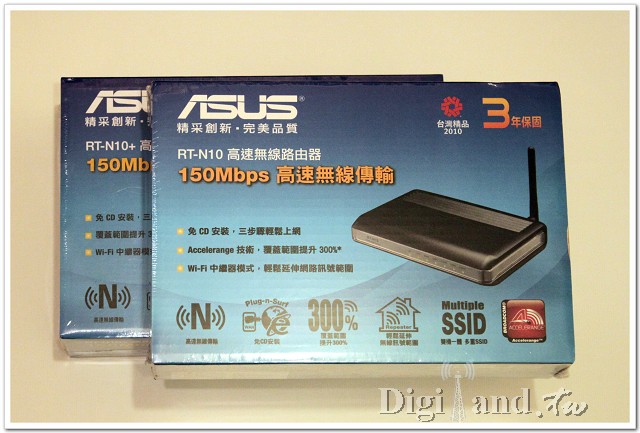
ASUS RT-N10 / RT-N10+(以下簡稱 RT-N10 serial)兩款皆具備 802.11n 150Mbps、1WAN 4LAN 10/100Mbps 的無線網路路由器,這兩款主打國內千元以下入門機種,鎖定上一代 802.11g 用戶換機風潮搶攻市場。根據型號編排上的定義,許多人都會直覺 RT-N10+ 多了一個"+"應該會是 RT-N10 的進階版本,究竟是不是進階版本,請繼續看我們的開箱分析。
RT-N10
商品條碼,生產地是大陸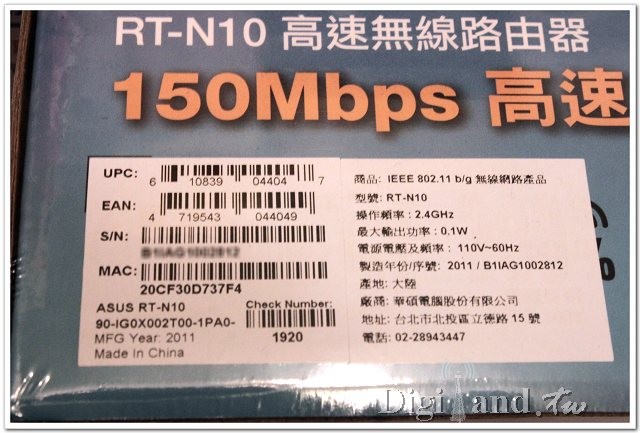
外包裝上有台灣精品,外加三年保固及Broadcom Accelerange™的技術加持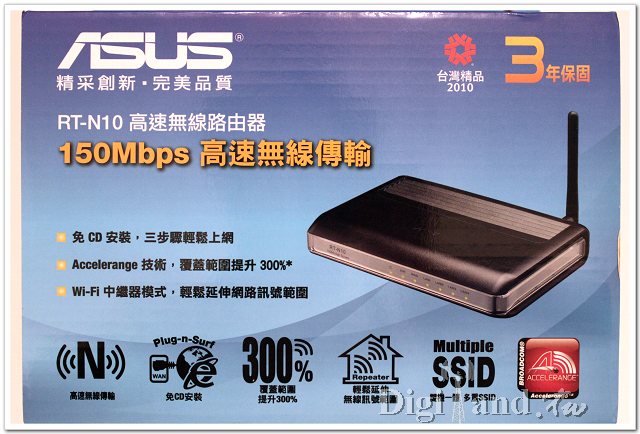
底部標籤,特別的是輸入電力規格是 DC 5V/1.2A 或 9V/1A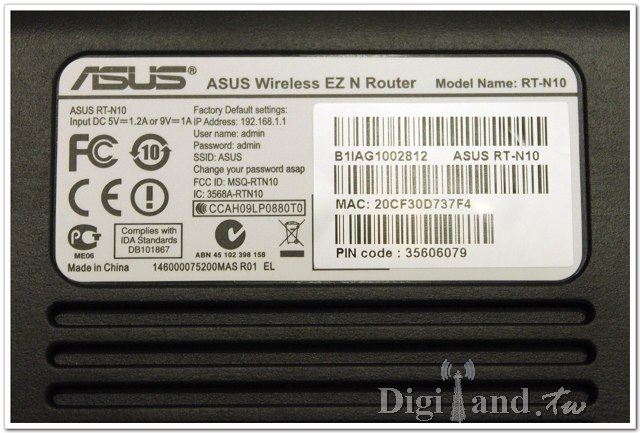
RT-N10 採用 SMA 天線接頭,旁邊是 EZSetup 及 Restore 按鍵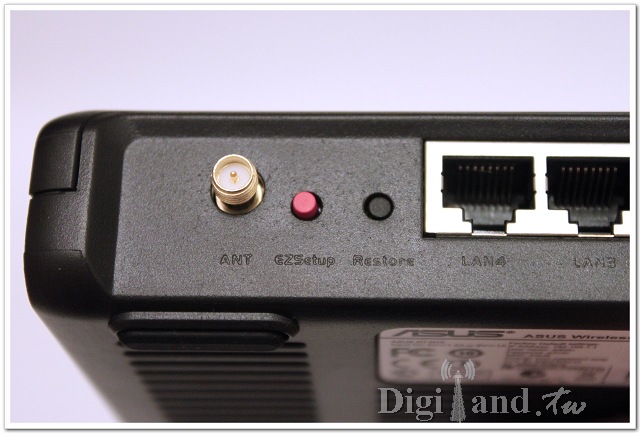
RT-N10+
商品條碼,產地也是大陸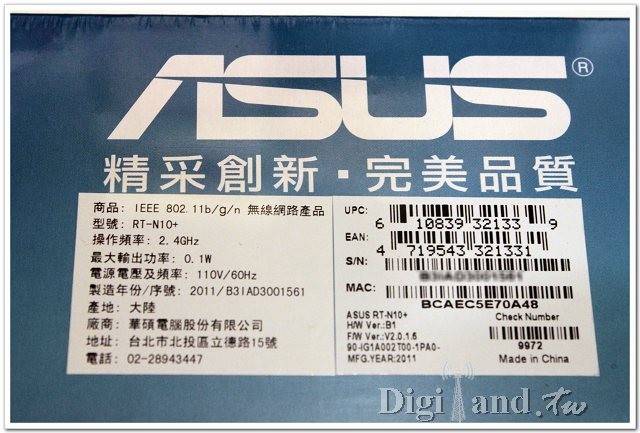
外包裝上同樣標示三年保固,不過似乎比 RT-N10 少了什麼(Ralink 怎沒弄個什麼獨家技術認證的貼紙)
底部標籤,硬體版本:B1,電力規格是 DC 12V/0.5A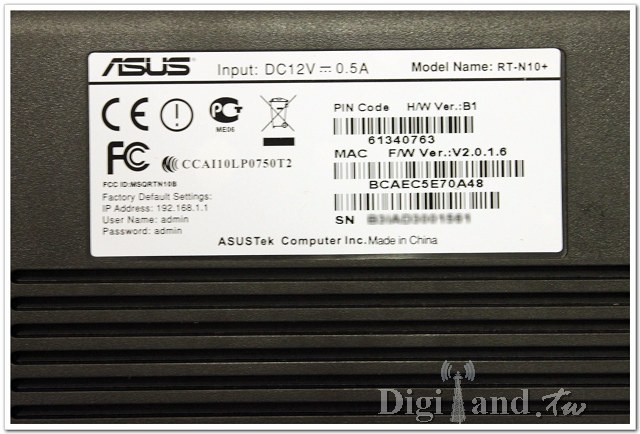
WPS 按鍵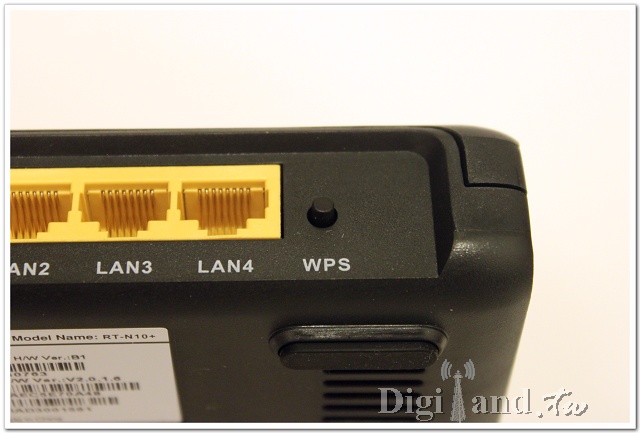
疊疊樂
疊在上者為 RT-N10 疊在下者是 RT-N10+,兩者外觀相似度高達 95%,而 RT-N10+ 體積稍稍比 RT-N10 大上一些,且多了一個 WPS 顯示燈號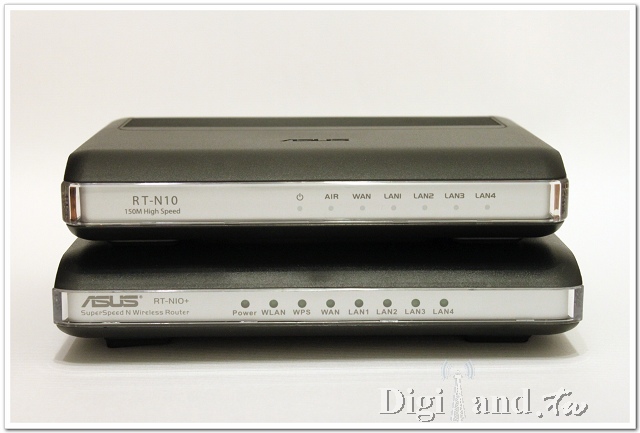
網路插孔:RT-N10+ 使用顏色區別 WAN/LAN 孔位及有黑底白字標示各項孔位及按鍵功能,反觀 RT-N10 在設計上並無顏色區別,連標示也都是黑底黑字,尤其是這兩台的 WAN port 位置剛好相反,筆者在測試過程中常常接錯孔位,錯把RT-N10 LAN4 錯當 WAN port 使用 
天線部份:RT-N10 使用 SMA 可拆式天線,而 RT-N10+ 則使用不可拆式天線 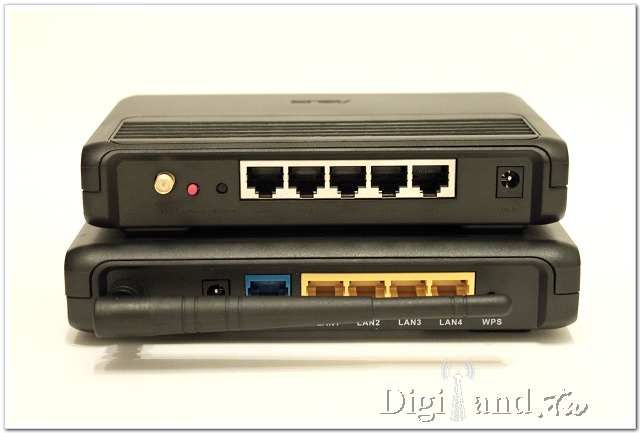
不過 RT-N10+ 採用 3dBi 天線硬是把 RT-N10 的小天線給比下去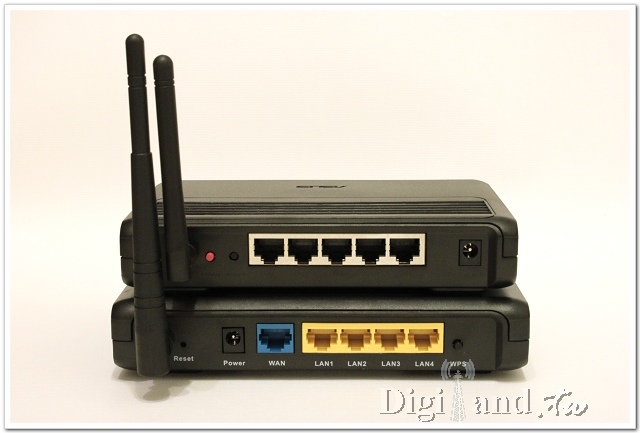
RT-N10 硬體規格
CPU: Broadcom BCM5356 300MHz
Flash: 4MB
RAM: 16MB
Wireless: 802.11n up to 150Mbps
Ethernet: 1 x WAN / 4 x LAN 10/100Mbps
RT-N10+ 硬體規格
CPU: Ralink RT3050F 320MHz
Flash: 4MB
RAM: 32MB
Wireless: 802.11n up to 150Mbps
Ethernet: 1 x WAN / 4 x LAN 10/100Mbps
技術問題請於論壇上集眾人之力公開討論,感恩

離線
#2 2011-05-08 22:29:33
Re: [兄弟鬩牆] ASUS RT-N10 / RT-N10+ 超級比一比
原廠韌體
RT-N10 Serial具有自動偵測使用者網路連線類型的功能,使用者無須手動指定家中 ISP 連線類型(PPPoE、固定IP、DHCP、PPTP、L2TP),系統會導引你快速建立網路使用環境。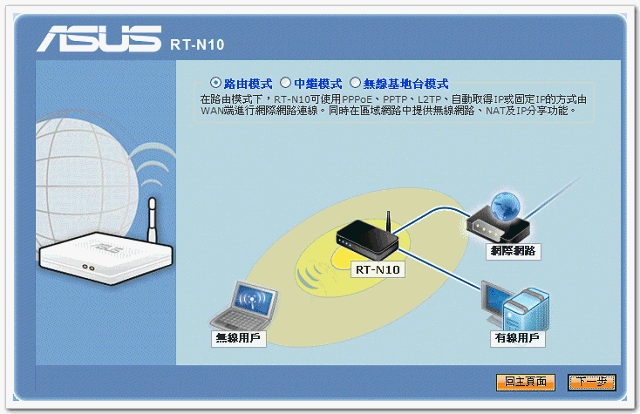
網路使用環境設定完成後,則會進到熟悉的網路地圖,RT-N10 Serial的使用者介面採用直覺、友善的圖形化設計,所有功能皆可透過點選圖示進行設定。若點選網路地圖的裝置圖示,使用者可分配頻寬優先權給不同的使用者,也可直接將非法入侵者封鎖。
啟用防火牆功能可為 RT-N10 Serial 及在其之後的裝置提供基本的保護。如果您要過濾出一些特定的封包,請採用在次頁中所述的LAN及WAN過濾功能。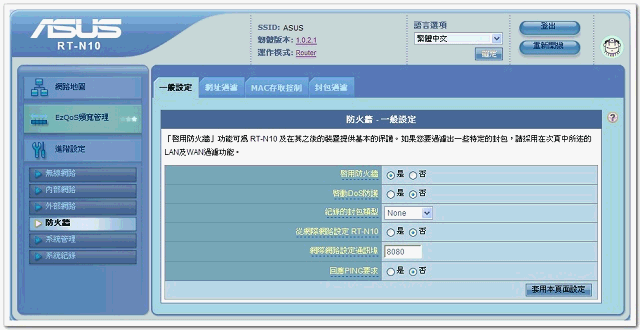
WPS (Wi-Fi Protected Setup) 是一種使用PIN密碼或是按鍵來設定網路安全性(包含無線連線是定)的方法,這裡只要輸入PIN密碼,即可快速完成 WPS 連線設定。
值得一提的是 RT-N10+ 的無線網路設定參數裡,則多出一項可調整功率的欄位,而 RT-N10 卻找不到這個欄位。
除了常見的 DDNS 服務商之外,ASUS 原廠也跳下來成立自己的 DDNS 服務自家客戶。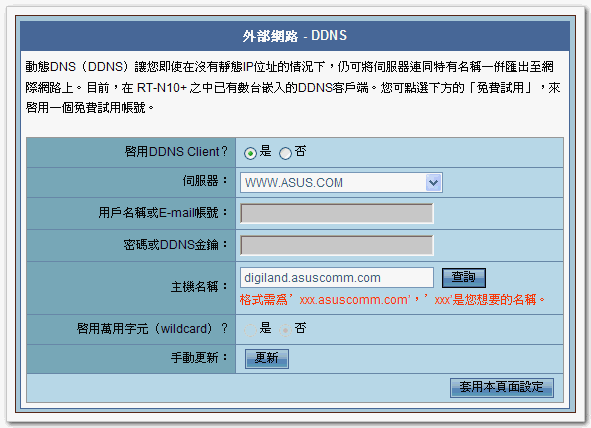
EZQoS頻寬管理提供四種常用的網路應用類型,透過EZQoS頻寬管理系統,使用者可自行分配頻寬優先順序給不同的網路應用程式 (ex.影音串流,遊戲封包,FTP封包...)以確保所需的網路需求不會"累格"。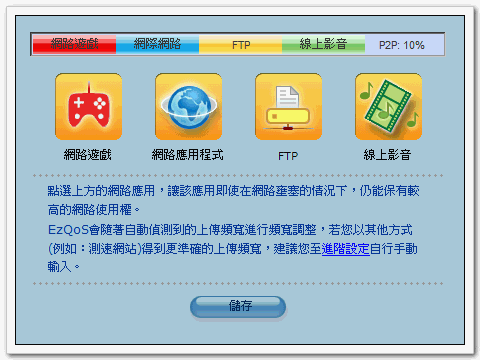
若EZQoS無法滿足或需要自行定義特殊服務頻寬優先權時,可以選擇"頻寬管理-使用者指定服務"功能,這個功能可以根據IP來定義頻寬優先順序。
WDS (Wireless Distribution System) 指的是以無線網路連接的方式所構成的一個整體網路,特別的是這是 RT-N10+ 原廠韌體才有的功能,RT-N10 上卻沒這個功能。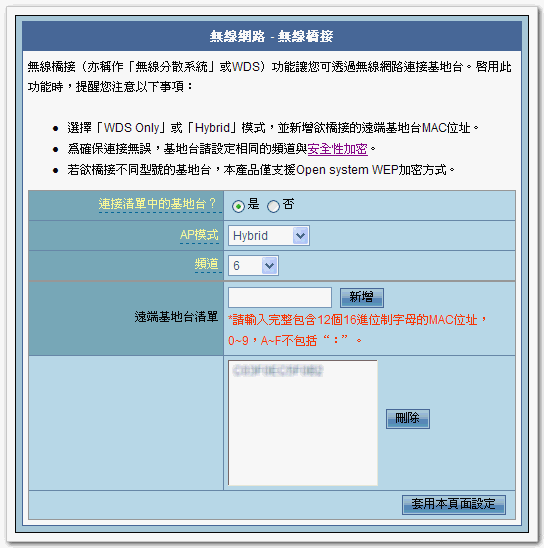
第三方韌體
支援 RT-N10 的第三方韌體
‧DD-WRT
據聞 RT-N10 刷了 DD-WRT 韌體後,無線網路功能會有問題,這次經刷 Eko 的V24-K26 DD-WRT 16773 voip small 版韌體,證實無線網路是可正常使用的,不過這個版本似乎沒有提供多國語言,只有英文界面(參考下圖)。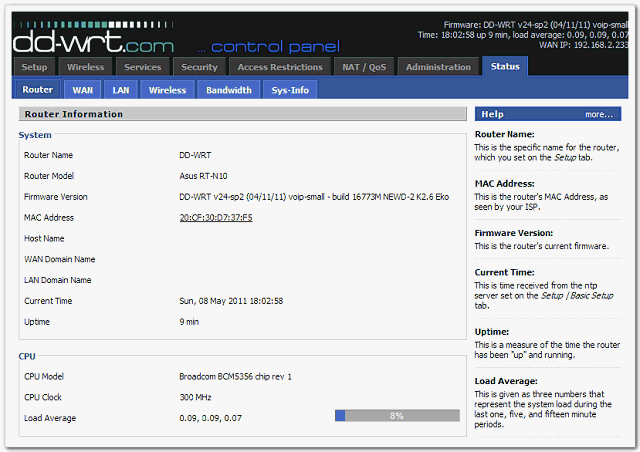
‧Tomato
因 Tomato usb build 52 之後的版本使用新版 Broadcom 驅動程式,而新版 Broadcom 驅動程式卻不支援 RT-N10 採用的 BCM5356 晶片,所以RT-N10 只能適用build 52 之前的版本或其他延伸版本。
目前適用 RT-N10 之 Tomato 版本有三:
1.tomato-K26-1.28.9054MIPSR2-beta-rtn10-Std.trx 是熱心網友針對 RT-N10 自行下載舊版驅動程式在加以編譯而成的。
2.twtomato 上的 tomato-K26-1.28.9052MIPSR2-beta23-vpn3.6.trx,已中文化且可支援 OpenVPN 功能。
3.Toastman 的 tomato-K26-1.28.7433MIPSR2-Toastman-Originalclassnames-Std.trx,可支援 Toastman QoS 及 IP 限速功能。
‧Oleg/Lly
突然忘了還有這一支老牌韌體繼續默默支援 RT-N10,雖然祖師爺 Oleg 已經退居幕後,但是正宗傳人Lly大師依舊持續在維護這一系列韌體,這支韌體的管理界面一直延續早期 ASUS 原廠韌體所使用的風格,雖然沒有花俏的管理界面,但是主要特色就是簡單直覺而且不拖泥帶水,本站最早就是架在其上陪伴我們走過草創階段,目前最新版本是 1.9.2.7-rtn-r2968。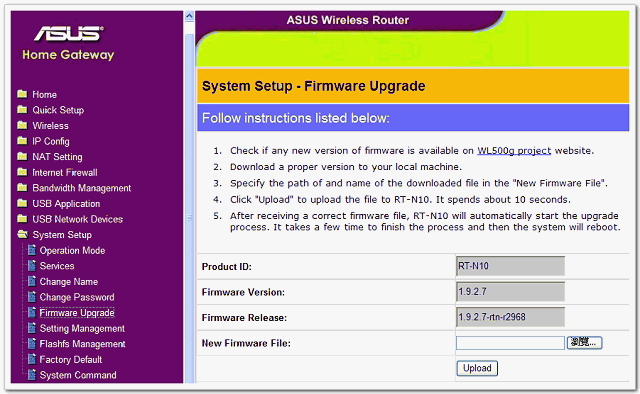
支援 RT-N10+ 的第三方韌體
‧DD-WRT
DD-WRT 支援 RT-N10+ 已經有一段時間了,底下是使用 DD-WRT 16785 std 版韌體。
‧Tomato DualWAN
Tomato DualWAN 為旗下一款 Ralink SoC Router - WR-500V 所特地編寫的韌體,據了解 WR-500V 與 RT-N10+ 兩者硬體電路相似度極高,大陸拍賣網上也有人成功將 RT-N10+ 刷上了 Tomato DualWAN,不過似乎得經過一些修改後才能刷。
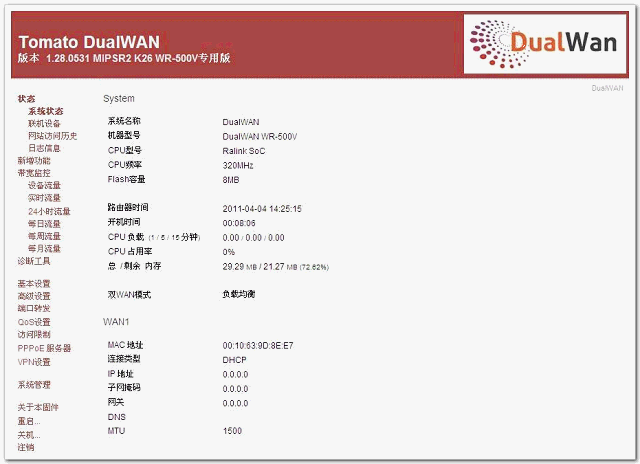
技術問題請於論壇上集眾人之力公開討論,感恩

離線
#3 2011-05-08 22:29:57
Re: [兄弟鬩牆] ASUS RT-N10 / RT-N10+ 超級比一比
CPU and memory benchmark
RT-N10
Total time: 27.2s
Overhead for getting time: 96us
Time to run memory bench: 4.53[secs]
Time to run computation of pi (2400 digits, 10 times): 9.93[secs]
Time to run computation of e (9009 digits): 8.65[secs]
Time to run float bench: 4.08[secs]
Total time: 27.2s
RT-N10+
Total time: 32.4s
Overhead for getting time: 44us
Time to run memory bench: 5.01[secs]
Time to run computation of pi (2400 digits, 10 times): 11.22[secs]
Time to run computation of e (9009 digits): 11.92[secs]
Time to run float bench: 4.25[secs]
Total time: 32.4s
網路效能
測試環境:
Server:Synology DS211 NAS
PC:ASUS EeeBOX B204 Windows XP
Firewall:disable
RT-N10
韌體版本 1.0.1.6
LAN to LAN:93.3Mbps
>iperf -c 192.168.1.70 -w 128k -t 60 -P 5
------------------------------------------------------------
Client connecting to 192.168.1.70, TCP port 5001
TCP window size: 128 KByte
------------------------------------------------------------
[1848] local 192.168.1.2 port 1325 connected with 192.168.1.70 port 5001
[1896] local 192.168.1.2 port 1322 connected with 192.168.1.70 port 5001
[1864] local 192.168.1.2 port 1324 connected with 192.168.1.70 port 5001
[1912] local 192.168.1.2 port 1321 connected with 192.168.1.70 port 5001
[1880] local 192.168.1.2 port 1323 connected with 192.168.1.70 port 5001
[ ID] Interval Transfer Bandwidth
[1864] 0.0-60.1 sec 134 MBytes 18.7 Mbits/sec
[1912] 0.0-60.1 sec 134 MBytes 18.7 Mbits/sec
[1896] 0.0-60.1 sec 134 MBytes 18.7 Mbits/sec
[1848] 0.0-60.1 sec 134 MBytes 18.6 Mbits/sec
[1880] 0.0-60.1 sec 133 MBytes 18.6 Mbits/sec
[SUM] 0.0-60.1 sec 668 MBytes 93.3 Mbits/sec
WLAN to LAN:68.8Mbps
>iperf -c 192.168.1.70 -w 128k -t 60 -P 5
------------------------------------------------------------
Client connecting to 192.168.1.70, TCP port 5001
TCP window size: 128 KByte
------------------------------------------------------------
[1848] local 192.168.1.4 port 1367 connected with 192.168.1.70 port 5001
[1880] local 192.168.1.4 port 1365 connected with 192.168.1.70 port 5001
[1864] local 192.168.1.4 port 1366 connected with 192.168.1.70 port 5001
[1912] local 192.168.1.4 port 1363 connected with 192.168.1.70 port 5001
[1896] local 192.168.1.4 port 1364 connected with 192.168.1.70 port 5001
[ ID] Interval Transfer Bandwidth
[1912] 0.0-60.1 sec 101 MBytes 14.2 Mbits/sec
[1864] 0.0-60.1 sec 95.2 MBytes 13.3 Mbits/sec
[1848] 0.0-60.1 sec 101 MBytes 14.1 Mbits/sec
[1896] 0.0-60.1 sec 94.3 MBytes 13.2 Mbits/sec
[1880] 0.0-60.1 sec 101 MBytes 14.1 Mbits/sec
[SUM] 0.0-60.1 sec 493 MBytes 68.8 Mbits/sec
LAN to WAN:93.2Mbps
>iperf -c 192.168.2.70 -w 128k -t 60 -P 5
------------------------------------------------------------
Client connecting to 192.168.2.70, TCP port 5001
TCP window size: 128 KByte
------------------------------------------------------------
[1912] local 192.168.1.2 port 3660 connected with 192.168.2.70 port 5001
[1864] local 192.168.1.2 port 3663 connected with 192.168.2.70 port 5001
[1880] local 192.168.1.2 port 3662 connected with 192.168.2.70 port 5001
[1896] local 192.168.1.2 port 3661 connected with 192.168.2.70 port 5001
[1848] local 192.168.1.2 port 3664 connected with 192.168.2.70 port 5001
[ ID] Interval Transfer Bandwidth
[1848] 0.0-60.1 sec 131 MBytes 18.2 Mbits/sec
[1896] 0.0-60.1 sec 143 MBytes 20.0 Mbits/sec
[1864] 0.0-60.1 sec 127 MBytes 17.8 Mbits/sec
[1912] 0.0-60.1 sec 129 MBytes 18.0 Mbits/sec
[1880] 0.0-60.1 sec 137 MBytes 19.1 Mbits/sec
[SUM] 0.0-60.1 sec 668 MBytes 93.2 Mbits/sec
WAN to LAN:94.0Mbps
> iperf -c 192.168.2.10 -w 128k -t 60 -P 5
------------------------------------------------------------
Client connecting to 192.168.2.10, TCP port 5001
TCP window size: 212 KByte (WARNING: requested 128 KByte)
------------------------------------------------------------
[ 7] local 192.168.2.70 port 59710 connected with 192.168.2.10 port 5001
[ 3] local 192.168.2.70 port 59706 connected with 192.168.2.10 port 5001
[ 4] local 192.168.2.70 port 59707 connected with 192.168.2.10 port 5001
[ 5] local 192.168.2.70 port 59708 connected with 192.168.2.10 port 5001
[ 6] local 192.168.2.70 port 59709 connected with 192.168.2.10 port 5001
[ ID] Interval Transfer Bandwidth
[ 5] 0.0-60.0 sec 123 MBytes 17.1 Mbits/sec
[ ID] Interval Transfer Bandwidth
[ 7] 0.0-60.0 sec 124 MBytes 17.3 Mbits/sec
[ ID] Interval Transfer Bandwidth
[ 4] 0.0-60.0 sec 152 MBytes 21.2 Mbits/sec
[ ID] Interval Transfer Bandwidth
[ 3] 0.0-60.0 sec 139 MBytes 19.4 Mbits/sec
[ ID] Interval Transfer Bandwidth
[ 6] 0.0-60.1 sec 137 MBytes 19.1 Mbits/sec
[SUM] 0.0-60.1 sec 673 MBytes 94.0 Mbits/sec
RT-N10+
韌體版本:2.0.1.6
LAN to LAN:93.3Mbps
>iperf -c 192.168.1.70 -w 128k -t 60 -P 5
------------------------------------------------------------
Client connecting to 192.168.1.70, TCP port 5001
TCP window size: 128 KByte
------------------------------------------------------------
[1896] local 192.168.1.3 port 2006 connected with 192.168.1.70 port 5001
[1880] local 192.168.1.3 port 2007 connected with 192.168.1.70 port 5001
[1912] local 192.168.1.3 port 2005 connected with 192.168.1.70 port 5001
[1848] local 192.168.1.3 port 2009 connected with 192.168.1.70 port 5001
[1864] local 192.168.1.3 port 2008 connected with 192.168.1.70 port 5001
[ ID] Interval Transfer Bandwidth
[1912] 0.0-60.1 sec 134 MBytes 18.6 Mbits/sec
[1896] 0.0-60.1 sec 134 MBytes 18.7 Mbits/sec
[1848] 0.0-60.1 sec 134 MBytes 18.7 Mbits/sec
[1880] 0.0-60.1 sec 134 MBytes 18.7 Mbits/sec
[1864] 0.0-60.1 sec 133 MBytes 18.6 Mbits/sec
[SUM] 0.0-60.1 sec 668 MBytes 93.3 Mbits/sec
WLAN to LAN:79.8Mbps
>iperf -c 192.168.1.70 -w 128k -t 60 -P 5
------------------------------------------------------------
Client connecting to 192.168.1.70, TCP port 5001
TCP window size: 128 KByte
------------------------------------------------------------
[1912] local 192.168.1.4 port 2016 connected with 192.168.1.70 port 5001
[1896] local 192.168.1.4 port 2017 connected with 192.168.1.70 port 5001
[1864] local 192.168.1.4 port 2019 connected with 192.168.1.70 port 5001
[1848] local 192.168.1.4 port 2020 connected with 192.168.1.70 port 5001
[1880] local 192.168.1.4 port 2018 connected with 192.168.1.70 port 5001
[ ID] Interval Transfer Bandwidth
[1864] 0.0-60.0 sec 115 MBytes 16.1 Mbits/sec
[1896] 0.0-60.0 sec 118 MBytes 16.5 Mbits/sec
[1880] 0.0-60.0 sec 116 MBytes 16.3 Mbits/sec
[1912] 0.0-60.0 sec 92.6 MBytes 12.9 Mbits/sec
[1848] 0.0-60.0 sec 129 MBytes 18.0 Mbits/sec
[SUM] 0.0-60.0 sec 571 MBytes 79.8 Mbits/sec
LAN to WAN:56.5Mbps
>iperf -c 192.168.2.70 -w 128k -t 60 -P 5
------------------------------------------------------------
Client connecting to 192.168.2.70, TCP port 5001
TCP window size: 128 KByte
------------------------------------------------------------
[1864] local 192.168.1.2 port 3258 connected with 192.168.2.70 port 5001
[1848] local 192.168.1.2 port 3259 connected with 192.168.2.70 port 5001
[1896] local 192.168.1.2 port 3256 connected with 192.168.2.70 port 5001
[1912] local 192.168.1.2 port 3255 connected with 192.168.2.70 port 5001
[1880] local 192.168.1.2 port 3257 connected with 192.168.2.70 port 5001
[ ID] Interval Transfer Bandwidth
[1864] 0.0-60.1 sec 80.9 MBytes 11.3 Mbits/sec
[1912] 0.0-60.1 sec 80.8 MBytes 11.3 Mbits/sec
[1880] 0.0-60.1 sec 80.6 MBytes 11.3 Mbits/sec
[1848] 0.0-60.1 sec 81.0 MBytes 11.3 Mbits/sec
[1896] 0.0-60.1 sec 81.2 MBytes 11.3 Mbits/sec
[SUM] 0.0-60.1 sec 405 MBytes 56.5 Mbits/sec
WAN to LAN:52.2Mbps
> iperf -c 192.168.2.10 -w 128k -t 60 -P 5
------------------------------------------------------------
Client connecting to 192.168.2.10, TCP port 5001
TCP window size: 212 KByte (WARNING: requested 128 KByte)
------------------------------------------------------------
[ 7] local 192.168.2.70 port 52851 connected with 192.168.2.10 port 5001
[ 3] local 192.168.2.70 port 52847 connected with 192.168.2.10 port 5001
[ 4] local 192.168.2.70 port 52848 connected with 192.168.2.10 port 5001
[ 5] local 192.168.2.70 port 52849 connected with 192.168.2.10 port 5001
[ 6] local 192.168.2.70 port 52850 connected with 192.168.2.10 port 5001
[ ID] Interval Transfer Bandwidth
[ 3] 0.0-60.0 sec 65.8 MBytes 9.19 Mbits/sec
[ ID] Interval Transfer Bandwidth
[ 7] 0.0-60.0 sec 92.5 MBytes 12.9 Mbits/sec
[ ID] Interval Transfer Bandwidth
[ 4] 0.0-60.1 sec 95.6 MBytes 13.4 Mbits/sec
[ ID] Interval Transfer Bandwidth
[ 5] 0.0-60.1 sec 58.9 MBytes 8.23 Mbits/sec
[ ID] Interval Transfer Bandwidth
[ 6] 0.0-60.1 sec 60.9 MBytes 8.49 Mbits/sec
[SUM] 0.0-60.1 sec 374 MBytes 52.2 Mbits/sec
彙總整理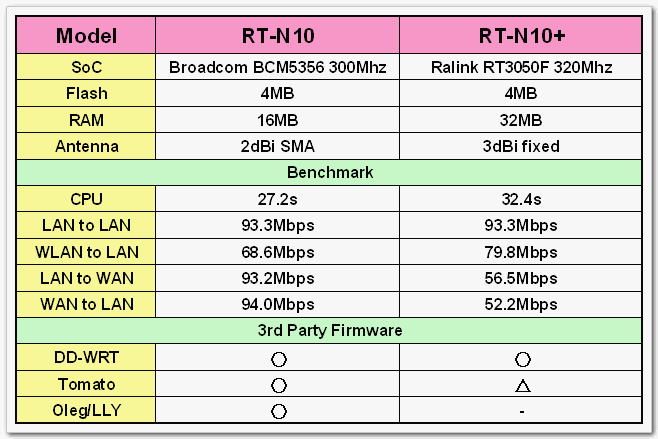
經過一番測試,我們將各項規格資訊及測試結果彙總整理如上圖表,看來兩者各有所長。以規格來看,RT-N10+ 的 32MB RAM 足足比 RT-N10 大上一倍,原廠提供的天線規格也比 RT-N10 優,的確有進階版的氣勢。不過以測試效能來看,RT-N10 也不是省油的燈,在 NAT 的效能上遙遙領先同門師兄弟,第三方韌體的支援度也優於 RT-N10+。此外,因測試環境的關係,我們還無法做連線數(Session)的測試,相信這一測試結果會對記憶體較大的 RT-N10+ 有利。最後,若對使用者採購上做一簡單推薦的話,我們會建議若就1~2人的使用環境推薦 RT-N10,若超過3人或有BT連線下載需求者推薦 RT-N10+。
技術問題請於論壇上集眾人之力公開討論,感恩

離線
#5 2011-05-09 11:50:15
Re: [兄弟鬩牆] ASUS RT-N10 / RT-N10+ 超級比一比
misol 提到:
建議:
把文中的 RT-N10s 都正名為 RT-N10+
文中不同地方出現 RT-N10s 與 RT-N10+ 易造成混淆,況且,好像沒有聽說過 RT-N10s 這個型號......
會不會讓人誤認呢?
會不會讓 Google 蜘蛛爬到呢?
只是建議.....謝
Sorry, 讓您誤會了
RT-N10s 是 RT-N10 serial 的意思,我還是改回 RT-N10 serial 好了
技術問題請於論壇上集眾人之力公開討論,感恩

離線
#8 2011-05-11 12:45:43
- violin_peter
- 新生

- 註冊日期: 2011-05-11
- 文章數: 10
- 目前積分 : 0
Re: [兄弟鬩牆] ASUS RT-N10 / RT-N10+ 超級比一比
感謝Aven不辭辛勞的測試
小弟一直在這邊潛水"做功課"
目前已使用Asus WL-520GU + Linksys WRT54G做WDS(對鎖MAC且已刷Tomato DualWAN)
由於RT-10N原廠韌體提供repeater mode
所以購入RT-N10增加無線覆蓋率並順道印證Tomato是否提供repeater mode
不過刷了Tomato各種版本都無法看到repeater mode選項
加上手上的linksys、ASUS刷Tomato都是一樣的情形
想請問Aven大是否repeater mode只能用"原廠"或是"DD-WRT"的韌體
最後修改: violin_peter (2011-05-11 12:55:52)
離線
#9 2011-05-12 09:38:22
Re: [兄弟鬩牆] ASUS RT-N10 / RT-N10+ 超級比一比
m72313 提到:
能否再針對Tomato & DD-WRT韌體去作效能比較,讓其他
網友知道那一個FW比較能發揮硬體效能。也可以讓貴站內容更豐富。
不同韌體的效能測試,過去也做過一次 ASUS RT-N16 四大韌體效能PK,後來就不敢再玩了
因為同時間只有一台機器,每個測試項目,測試環境就需要調整一次,四個韌體x四個項目這樣循環下來,真的不好玩
除非廠商願意同時借測四台機器,四台同時刷不同版本韌體,那同一測試環境就可以馬上進行四個韌體測試,這樣或許可以考慮
只能說您提的意見並非不可行,而是需要的是時間,如果M兄有意願分享測試,我們樂見其成。
技術問題請於論壇上集眾人之力公開討論,感恩

離線
#10 2011-05-12 10:15:47
Re: [兄弟鬩牆] ASUS RT-N10 / RT-N10+ 超級比一比
violin_peter 提到:
由於RT-10N原廠韌體提供repeater mode
所以購入RT-N10增加無線覆蓋率並順道印證Tomato是否提供repeater mode
不過刷了Tomato各種版本都無法看到repeater mode選項
加上手上的linksys、ASUS刷Tomato都是一樣的情形
想請問Aven大是否repeater mode只能用"原廠"或是"DD-WRT"的韌體
應先確認需求,再來思考用什麼方式來達成
Tomato 各版本似乎都沒有支援單純的 repeater mode,但是應該都有 Wireless Ethernet Bridge mode 無線網路橋接模式 這和原廠韌體所提供的中繼模式應該都是一樣的功能。
技術問題請於論壇上集眾人之力公開討論,感恩

離線
相關討論主題
| 主題 | 回覆 | 點閱 | 最後發表 |
|---|---|---|---|
|
ASUS RT-N66U刷Shibby 140 MultiWAN後設定為無線AP 作者 lcjh20516
|
0 | 3484 | 2022-08-26 12:56:28 作者 lcjh20516 |
|
|
159 | 440589 | 2022-08-14 06:06:27 作者 lcjh20516 |
|
|
21 | 94078 | 2022-08-14 05:54:54 作者 lcjh20516 |
|
置頂 |
132 | 422930 | 2022-06-07 10:13:50 作者 dennys |
|
|
45 | 158129 | 2022-05-06 14:32:17 作者 max7441 |





